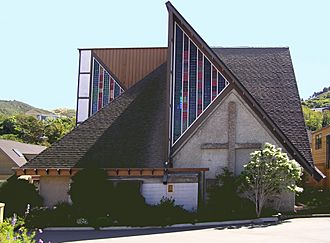Futuna Chapel facts for kids
Quick facts for kids Futuna Chapel |
|
|---|---|
 |
|
| General information | |
| Type | Chapel |
| Location | Friend St, Karori, Wellington, New Zealand |
| Construction started | 1958 |
| Completed | 1961 |
| Owner | Friends of Futuna Trust |
| Design and construction | |
| Architect | John Scott |
| Awards and prizes | NZIA Gold Medal (1968) NZIA 25-year award (1986) |
| Designated: | 28-May-1999 |
| Reference #: | 7446 |
The Futuna Chapel is a special building in Wellington, New Zealand. A famous architect named John Scott designed it.
The chapel was built by the brothers of the Society of Mary. It is named after Futuna, a Pacific Island. A missionary named Peter Chanel was honored here. The chapel won the New Zealand Institute of Architects gold medal in 1968. It also received their 25-year Award in 1986. The Historic Places Trust has listed it as a Category 1 Historic Site. This means it is a very important historical place.
Contents
History of Futuna Chapel
The Society of Mary started their Karori Centre in 1948. They used an old house that belonged to Sidney Kirkcaldie. In 1958, they asked John Scott to design the Futuna Retreat Chapel. The brothers built the chapel themselves in 1961. Only the electrician was hired from outside.
Where the Chapel is Located
The chapel was first built at 62-66 Friend Street in Karori, Wellington. It is set back from the main street. You enter the building from the north-west side. The chapel was placed between three other buildings. These included an office and two places for people to stay.
How the Chapel Was Built
The floors of the chapel are made of concrete slabs. Inside, they are covered with flat stones. The walls are made from a mix of poured concrete and concrete blocks. Both the inside and outside walls have a rough plaster finish. Some concrete block walls are left uncovered.
The roof is made of timber (wood) and was once covered with asbestos shingles. A large wooden post in the middle supports the main roof. Wooden beams help hold it up. The ceiling shows the wooden rafters and timber lining. The triangle-shaped windows high up let in light. They are made of clear and colored plastic. The benches where people sit are made of concrete and wood.
Why Futuna Chapel is Important
Futuna Chapel is important because John Scott mixed different building styles. The central wooden post looks like the main post in a traditional Māori meeting house, called a wharenui. The steep roof also reminds people of the entrance to a wharenui.
The chapel also shows ideas from a famous architect named Le Corbusier. You can see this in the rough concrete walls. The way light comes in from high windows makes the inside look dramatic. The building shows how different materials meet. The roof structure is visible inside. This shows how the building fights against gravity, like old Gothic buildings. The use of wood for the roof shows the skill of New Zealand carpenters from the 1960s and 70s.
A book about the chapel was published in 1987. It was called ‘Voices of Silence (New Zealand’s Chapel of Futuna)’. The author, Russell Walden, said the building mixes Māori and European ideas. He believed it was a modern building with geometric shapes. But it also had parts like a marae, such as the big center pole and sloping roof edges. Walden thought John Scott created a unique blend of architecture.
Current State of the Chapel
In 2000, the Society of Mary no longer needed the Futuna Retreat. They sold it to a builder named Art Potter. The buildings around the chapel were taken down. New homes were built there instead. The chapel itself was saved from being demolished by a local plan. While the new homes were being built, the chapel was used to store building materials.
Most of the chapel's parts are still in good shape. However, a wooden sculpture of the Crucifixion by Jim Allen went missing. In September 2012, police found the sculpture on a farm. It was put back in the chapel in early 2013 after being fixed up.
Many people were worried about the chapel's future. This led to the creation of the Friends of Futuna Charitable Trust. In 2006, this Trust bought the chapel and the land it sits on. The Trust has a plan to fix and improve the building. Some windows have rot, and some outside wood needs repair. The original roof shingles were replaced with metal tiles, which don't match the building's style. The Trust is still looking for a better roofing solution. A new accessible toilet was added recently. This allows more events to be held at the chapel.
Images for kids
See also
 In Spanish: Capilla de Futuna para niños
In Spanish: Capilla de Futuna para niños








